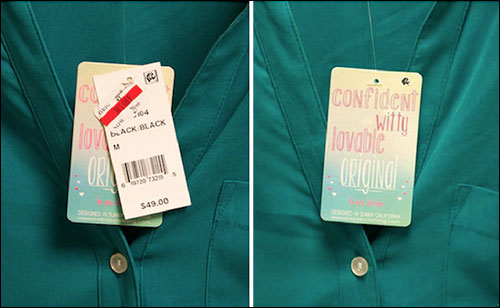The apparel industry is embracing radio frequency identification with perhaps more ardor than any other sector. Its nearly endless host of stock-keeping units (SKUs), combined with rapid item turnover at the retail level, make apparel inventories notoriously difficult to manage. RFID offers a solution, but one that traditionally involved some undesirable tradeoffs in terms of tagging costs, minimum order requirements and unattractive additional Electronic Product Code (EPC) item tags.
But that is now changing.

Advancements in RFID tag production, and the technology’s deployment to strategically located tag-manufacturing facilities worldwide, are enabling apparel retailers to implement RFID at less cost and in ways that support their brand imaging. Here’s how:
Retailers typically begin their RFID initiatives by testing a system at stores where the environment can be tightly controlled. Initial evaluations concentrate on hardware and software selection, as well as their integration into the existing infrastructure.

As retailers move from evaluation to implementation, their attention shifts to operating costs. They soon learn that item-level tagging’s two major cost components are the purchase of RFID tags or stickers and the labor required to apply them.
During initial RFID trials, sales associates or stock-room personnel are usually assigned the task of applying RFID tags to garments. These employee costs can range anywhere from $.06 to $0.12 per item.
Such store tagging is not sustainable over the long term, nor is it a good use of personnel. The long-term cost-effective solution, just like with traditional price ticketing, is to have vendors tag the garments farther up the supply chain, where it can be done much more cost-efficiently.
The other part of the cost equation involves retailers purchasing RFID tags or stickers for additional trim items. The tags are either secondary tickets embedded with RFID inlays, or are in some way applied to existing brand or price tags. This dual ticketing adds to a garment’s cost.
Secondary RFID stickers or tags can also detract from the presentation of garments on the store floor. The tags or stickers can cover parts of the brand logo or important consumer information, such as size or price.
Beyond that, says Linda Sarentino, PVH Corp.‘s group VP of strategic services, “applying a secondary RFID sticker to a garment during the manufacturing process not only costs more money, but it also increases the chances of someone applying the wrong EPC-encoded tag to the existing printed UPC price ticket. This, in turn, could lead to inaccurate store inventory levels.”
Integrated RFID Tags
Tag production technology implemented at global tag manufacturing plants is helping to solve both the cost and branding issues that have undercut RFID’s overall value in the apparel industry.
Initial RFID-tagging technology was not conducive to integrating the RFID inlays into the many different and customized ticket forms commonly found on garments today. With technology advancements, tags can now be manufactured with RFID inlays embedded in a single tag of virtually any shape and graphic design, as well as all necessary variable data. This single integrated RFID tag eliminates the cost of purchasing and applying separate RFID tags or stickers, as well as the potential for obscuring the brand tag or price ticket. RFID tags can now take the form of the most stylish promotional branded tag.
Moreover, with some major tag manufacturers having expanded their operations to key locations worldwide, retailers can now order RFID tags locally, and have them produced in proximity to the point of apparel manufacture and delivered quickly. Turnaround times of 48 hours worldwide, with no annual quantity or inventory commitments, are now possible. Costs for applying RFID tags in apparel-producing locations such as China and India can range from $.007 to $.014 apiece, or about 1/10th the cost of applying them at North American retail locations.
The movement to integrated RFID tags and having them applied at the point of manufacture will further drive down item-tagging costs. This, in turn, should lead to further and more rapid adoption of RFID throughout the apparel retail industry.
George Hoffman is the CEO of FineLine Technologies, which provides a large variety of bar-code ticketing and RFID tagging solutions for retailers, vendors and manufacturers around the world.

